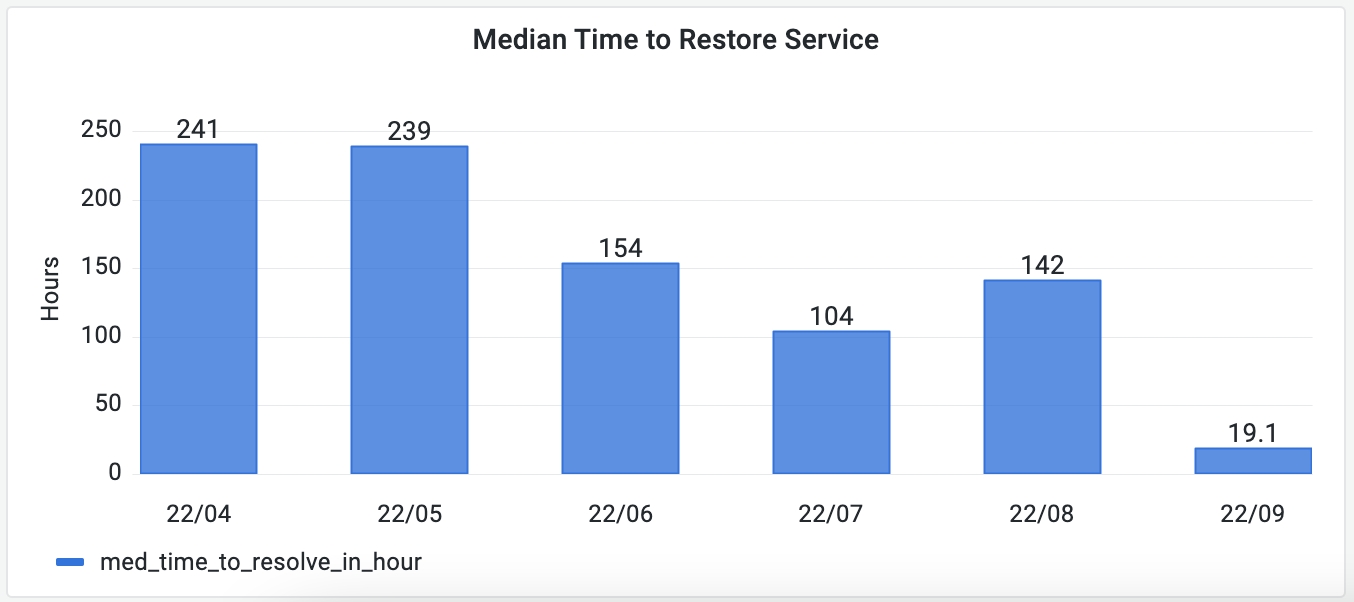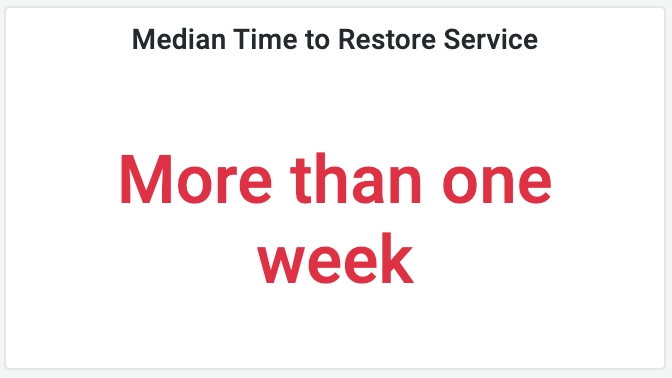DORA - Median Time to Restore Service
What is this metric?
The time to restore service after service incidents, rollbacks, or any type of production failure happened.
Why is it important?
This metric is essential to measure the disaster control capability of your team and the robustness of the software.
Which dashboard(s) does it exist in
DORA dashboard. See live demo.
How is it calculated?
MTTR = Total incident age (in hours)/number of incidents.
If you have three incidents that happened in the given data range, one lasting 1 hour, one lasting 2 hours and one lasting 3 hours. Your MTTR will be: (1 + 2 + 3) / 3 = 2 hours.
Below are the benchmarks for different development teams from Google's report. However, it's difficult to tell which group a team falls into when the team's median time to restore service is between one week and six months. Therefore, DevLake provides its own benchmarks to address this problem:
| Groups | Benchmarks | DevLake Benchmarks |
|---|---|---|
| Elite performers | Less than one hour | Less than one hour |
| High performers | Less one day | Less than one day |
| Medium performers | Between one day and one week | Between one day and one week |
| Low performers | More than six months | More than one week |
Source: 2021 Accelerate State of DevOps, Google
Data Sources RequiredThis metric relies on:
Deploymentscollected in one of the following ways:- Open APIs of Jenkins, GitLab, GitHub, etc.
- Webhook for general CI tools.
- Releases and PR/MRs from GitHub, GitLab APIs, etc.
Incidentscollected in one of the following ways:- Issue tracking tools such as Jira, TAPD, GitHub, etc.
- Incident or Service Monitoring tools such as PagerDuty, ServiceNow, etc.
This metric relies on:
- Deployment configuration in Jenkins, GitLab or GitHub transformation rules to let DevLake know what CI builds/jobs can be regarded as
Deployments. - Incident configuration in Jira, GitHub or TAPD transformation rules to let DevLake know what CI builds/jobs can be regarded as
Incidents.
If you want to measure the monthly trend of median time to restore service as the picture shown below, run the following SQL in Grafana.

with _incidents as (
-- get the incident count each month
SELECT
date_format(created_date,'%y/%m') as month,
cast(lead_time_minutes as signed) as lead_time_minutes
FROM
issues
WHERE
type = 'INCIDENT'
),
_find_median_mttr_each_month as (
SELECT
x.*
from _incidents x join _incidents y on x.month = y.month
WHERE x.lead_time_minutes is not null and y.lead_time_minutes is not null
GROUP BY x.month, x.lead_time_minutes
HAVING SUM(SIGN(1-SIGN(y.lead_time_minutes-x.lead_time_minutes)))/COUNT(*) > 0.5
),
_find_mttr_rank_each_month as (
SELECT
*,
rank() over(PARTITION BY month ORDER BY lead_time_minutes) as _rank
FROM
_find_median_mttr_each_month
),
_mttr as (
SELECT
month,
lead_time_minutes as med_time_to_resolve
from _find_mttr_rank_each_month
WHERE _rank = 1
),
_calendar_months as(
-- deal with the month with no incidents
SELECT date_format(CAST((SYSDATE()-INTERVAL (month_index) MONTH) AS date), '%y/%m') as month
FROM ( SELECT 0 month_index
UNION ALL SELECT 1 UNION ALL SELECT 2 UNION ALL SELECT 3
UNION ALL SELECT 4 UNION ALL SELECT 5 UNION ALL SELECT 6
UNION ALL SELECT 7 UNION ALL SELECT 8 UNION ALL SELECT 9
UNION ALL SELECT 10 UNION ALL SELECT 11
) month_index
WHERE (SYSDATE()-INTERVAL (month_index) MONTH) > SYSDATE()-INTERVAL 6 MONTH
)
SELECT
cm.month,
case
when m.med_time_to_resolve is null then 0
else m.med_time_to_resolve/60 end as med_time_to_resolve_in_hour
FROM
_calendar_months cm
left join _mttr m on cm.month = m.month
ORDER BY 1
If you want to measure in which category your team falls into as the picture shown below, run the following SQL in Grafana.

with _incidents as (
-- get the incidents created within the selected time period in the top-right corner
SELECT
cast(lead_time_minutes as signed) as lead_time_minutes
FROM
issues
WHERE
type = 'INCIDENT'
and $__timeFilter(created_date)
),
_median_mttr as (
SELECT
x.lead_time_minutes as med_time_to_resolve
from _incidents x, _incidents y
WHERE x.lead_time_minutes is not null and y.lead_time_minutes is not null
GROUP BY x.lead_time_minutes
HAVING SUM(SIGN(1-SIGN(y.lead_time_minutes-x.lead_time_minutes)))/COUNT(*) > 0.5
LIMIT 1
)
SELECT
case
WHEN med_time_to_resolve < 60 then "Less than one hour"
WHEN med_time_to_resolve < 24 * 60 then "Less than one Day"
WHEN med_time_to_resolve < 7 * 24 * 60 then "Between one day and one week"
ELSE "More than one week"
END as med_time_to_resolve
FROM
_median_mttr
How to improve?
- Use automated tools to quickly report failure
- Prioritize recovery when a failure happens
- Establish a go-to action plan to respond to failures immediately
- Reduce the deployment time for failure-fixing